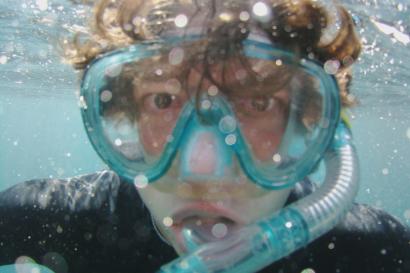To get to Isla Española from San Cristóbal, you must first endure 2 hours of agony.
In a boat the size of a single dorm room, with a motor the size of a four-year-old, you are ripped through completely by miles of ocean. At 7:10 a.m., half of my classmates were sleeping (the half from Florida), while the other half were using every ounce of willpower they could muster not to puke everywhere. Needless to say, I was in the second group. Before this, the only boats I had ever rode were on still lakes and river rapids. The ocean is a different beast. As I clutched my stomach, grateful to have skipped my morning coffee, I stared out onto the horizon, looking for any still point to fixate on. As the caldera of San Cristóbal collapsed from my vision, all I had was the wide open sky.
If you’ve ever been seasick, you know that the worst part about the whole endeavor is the fact that there is no stopping. Even when the motor ceases, the ocean around you is a neverending lurching. In a car, you can get out and breathe. A boat is less of a car than it is a parachute with a steering wheel. All boats really do is resist digestion by water, and I was caught in the roaring of the hungry ocean. As I tried (and failed) to sleep the hours away, all of the little beachy indie songs in my headphones only intensified the nausea (note: I wouldn’t recommend listening to "tuff girl" by strongboi or anything by beach house on a ship hurdling through the ocean).
As we approached the uninhabited Isla Española, the geologically oldest island in the Galápagos archipelago, we had to hop from one boat onto another (even smaller) boat, for our “wet landing.” We took our shoes off and rode the hills of water another halfmile to the shore, where we waded through knee deep licking ocean to the coarse beach. Immediately, we spotted the infamous marine iguanas all over the rocks, striking blue and cherry red as if their bodies had been rolled in Fun Dip. On the huge volcanic rocks near the beach, there were dozens of blue—and red—footed boobies, Nazca boobies, hawks, albatross, and mockingbirds. Above all, Española is an island of birds. Everywhere you turn, there are hundreds, maybe thousands of nesting, feeding, pruning, diabolical birds with juveniles the size of a human baby. They say that a baby Nazca booby can eat half a marine iguana a day. I’d like to see the size of that egg!
Not only is Española uninhabited, it is never inhabited. You can tell by the trails– obviously made for birds, not people. Every route is made of huge, sharp chunks of basalt. If I had been wearing anything other than hiking shoes, I surely would have busted my ass on the first step. Because there is no freshwater on the island, all the plants that dare survive drink seawater filtered through the air. There are swathes of bulbous, anemone-looking plants in bright orange. They kind of look like succulents, or salt-flavored gushers. It took everything in my power not to try and pop them. I was shocked to see them so still, half expected them to sway as if underwater. The island is also covered (I mean COVERED) in bird shit. There is so much bird shit that the ground is literally white. It gathers in clumps on all the rocks. And the SMELL…don’t get me started on the smell. My parents had a cockatoo in the living room for 20 years of my life. Imagine a whole island that smells like a year-old dirty birdcage. Española is the antithesis of, say, a hotel room. It is maybe the most inhospitable place on Earth; even the sea route is hell enough to deter weak-stomached fellows such as myself. I understand why early humans never chose this island. Everything about the land is hostile to human touch. Nothing screams “settle” like having nowhere to sit. For the birds, there is no need for shelter, flat land, or water.
¨
For so long the Earth has been conceptualized as a cornucopia of resources for our human manipulation. At least in the Western imagination. Cue the footage of dynamite boring holes through the Rocky Mountains for the railroad, cue the diamond mines outsourced to Botswana, the oil rigs dissecting Oklahoma and Texas. The wilderness has never been more than a mere annoyance in the grand plan of human development, according especially to the United States. Here, there is nothing for us. Not even a shady tree to catch your breath. Coming from a place so manipulated as the U.S., it is surreal to see a place so utterly untouched by humanity.
Except for these:
On the beach, a bright blue plastic ziptie.
On the trail, a mockingbird smashed against a rock in a shoeprint.
According to historical legend, there were no humans in the Galápagos before Darwin. Only the animals, the plants, and the sky.
When discussing the goats brought to the Galápagos by Norwegian settlers (yeah, really) the naturalist guides tell us the reason why they have been so destructive is that they evolved in a place where there were wolves to eat them. Like the goats, we have situated ourselves in such a way here that we have no natural predators. Our plastic, our Styrofoam, our asphalt, snuffs all natural hostility into compliance with the Anthropocene. There are so few places left untouched in this world: even here, an island with nothing we need.
How can I justify my own body in this place? My footprints, the carbon in my breath: How can I justify all that I have left?

Anna Sverclova
My name is Anna Šverclová. I'm a published poet and creative writing major at Macalester College. I love exploring the world around me. You can almost always find me digging in the mud by the river, journal in my back pocket. My writing focuses on my relationship with the world, childhood trauma, and my hometown. I write both for the page and for performance. You can find me at annasverclova.com








